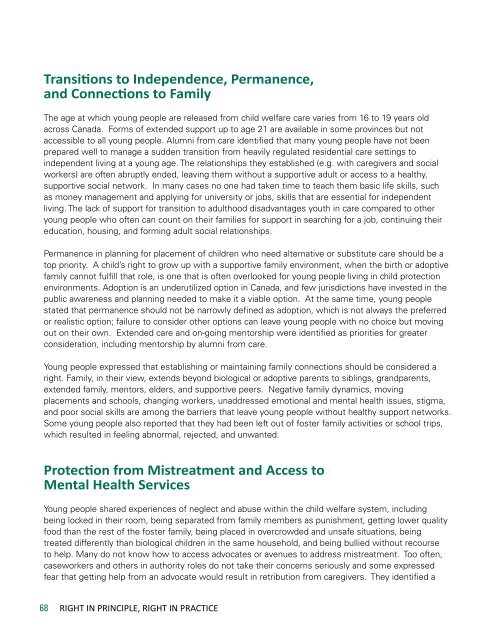CCRC report on rights of children in Canada - Canadian Coalition ...
CCRC report on rights of children in Canada - Canadian Coalition ...
CCRC report on rights of children in Canada - Canadian Coalition ...
Create successful ePaper yourself
Turn your PDF publications into a flip-book with our unique Google optimized e-Paper software.
Transiti<strong>on</strong>s to Independence, Permanence,<br />
and C<strong>on</strong>necti<strong>on</strong>s to Family<br />
The age at which young people are released from child welfare care varies from 16 to 19 years old<br />
across <strong>Canada</strong>. Forms <strong>of</strong> extended support up to age 21 are available <strong>in</strong> some prov<strong>in</strong>ces but not<br />
accessible to all young people. Alumni from care identified that many young people have not been<br />
prepared well to manage a sudden transiti<strong>on</strong> from heavily regulated residential care sett<strong>in</strong>gs to<br />
<strong>in</strong>dependent liv<strong>in</strong>g at a young age. The relati<strong>on</strong>ships they established (e.g. with caregivers and social<br />
workers) are <strong>of</strong>ten abruptly ended, leav<strong>in</strong>g them without a supportive adult or access to a healthy,<br />
supportive social network. In many cases no <strong>on</strong>e had taken time to teach them basic life skills, such<br />
as m<strong>on</strong>ey management and apply<strong>in</strong>g for university or jobs, skills that are essential for <strong>in</strong>dependent<br />
liv<strong>in</strong>g. The lack <strong>of</strong> support for transiti<strong>on</strong> to adulthood disadvantages youth <strong>in</strong> care compared to other<br />
young people who <strong>of</strong>ten can count <strong>on</strong> their families for support <strong>in</strong> search<strong>in</strong>g for a job, c<strong>on</strong>t<strong>in</strong>u<strong>in</strong>g their<br />
educati<strong>on</strong>, hous<strong>in</strong>g, and form<strong>in</strong>g adult social relati<strong>on</strong>ships.<br />
Permanence <strong>in</strong> plann<strong>in</strong>g for placement <strong>of</strong> <strong>children</strong> who need alternative or substitute care should be a<br />
top priority. A child’s right to grow up with a supportive family envir<strong>on</strong>ment, when the birth or adoptive<br />
family cannot fulfill that role, is <strong>on</strong>e that is <strong>of</strong>ten overlooked for young people liv<strong>in</strong>g <strong>in</strong> child protecti<strong>on</strong><br />
envir<strong>on</strong>ments. Adopti<strong>on</strong> is an underutilized opti<strong>on</strong> <strong>in</strong> <strong>Canada</strong>, and few jurisdicti<strong>on</strong>s have <strong>in</strong>vested <strong>in</strong> the<br />
public awareness and plann<strong>in</strong>g needed to make it a viable opti<strong>on</strong>. At the same time, young people<br />
stated that permanence should not be narrowly def<strong>in</strong>ed as adopti<strong>on</strong>, which is not always the preferred<br />
or realistic opti<strong>on</strong>; failure to c<strong>on</strong>sider other opti<strong>on</strong>s can leave young people with no choice but mov<strong>in</strong>g<br />
out <strong>on</strong> their own. Extended care and <strong>on</strong>-go<strong>in</strong>g mentorship were identified as priorities for greater<br />
c<strong>on</strong>siderati<strong>on</strong>, <strong>in</strong>clud<strong>in</strong>g mentorship by alumni from care.<br />
Young people expressed that establish<strong>in</strong>g or ma<strong>in</strong>ta<strong>in</strong><strong>in</strong>g family c<strong>on</strong>necti<strong>on</strong>s should be c<strong>on</strong>sidered a<br />
right. Family, <strong>in</strong> their view, extends bey<strong>on</strong>d biological or adoptive parents to sibl<strong>in</strong>gs, grandparents,<br />
extended family, mentors, elders, and supportive peers. Negative family dynamics, mov<strong>in</strong>g<br />
placements and schools, chang<strong>in</strong>g workers, unaddressed emoti<strong>on</strong>al and mental health issues, stigma,<br />
and poor social skills are am<strong>on</strong>g the barriers that leave young people without healthy support networks.<br />
Some young people also <str<strong>on</strong>g>report</str<strong>on</strong>g>ed that they had been left out <strong>of</strong> foster family activities or school trips,<br />
which resulted <strong>in</strong> feel<strong>in</strong>g abnormal, rejected, and unwanted.<br />
Protecti<strong>on</strong> from Mistreatment and Access to<br />
Mental Health Services<br />
Young people shared experiences <strong>of</strong> neglect and abuse with<strong>in</strong> the child welfare system, <strong>in</strong>clud<strong>in</strong>g<br />
be<strong>in</strong>g locked <strong>in</strong> their room, be<strong>in</strong>g separated from family members as punishment, gett<strong>in</strong>g lower quality<br />
food than the rest <strong>of</strong> the foster family, be<strong>in</strong>g placed <strong>in</strong> overcrowded and unsafe situati<strong>on</strong>s, be<strong>in</strong>g<br />
treated differently than biological <strong>children</strong> <strong>in</strong> the same household, and be<strong>in</strong>g bullied without recourse<br />
to help. Many do not know how to access advocates or avenues to address mistreatment. Too <strong>of</strong>ten,<br />
caseworkers and others <strong>in</strong> authority roles do not take their c<strong>on</strong>cerns seriously and some expressed<br />
fear that gett<strong>in</strong>g help from an advocate would result <strong>in</strong> retributi<strong>on</strong> from caregivers. They identified a<br />
lack <strong>of</strong> m<strong>on</strong>itor<strong>in</strong>g <strong>of</strong> quality <strong>of</strong> care and shared stories <strong>of</strong> peers who fell through the cracks <strong>of</strong> child<br />
welfare, got <strong>in</strong>to trouble with the law and ended up <strong>in</strong> the crim<strong>in</strong>al justice system.<br />
The fact that physical punishment is c<strong>on</strong>d<strong>on</strong>ed by law <strong>in</strong> <strong>Canada</strong> makes it more difficult for social<br />
workers and child protecti<strong>on</strong> workers to promote more effective forms <strong>of</strong> discipl<strong>in</strong>e to parents and<br />
other caregivers, when <strong>children</strong> misbehave. Other countries that have legislated the right <strong>of</strong> <strong>children</strong> to<br />
be free from all forms <strong>of</strong> violence, <strong>in</strong>clud<strong>in</strong>g physical punishment, have seen an <strong>in</strong>crease <strong>in</strong> the use <strong>of</strong><br />
more effective forms <strong>of</strong> discipl<strong>in</strong>e. 68<br />
In additi<strong>on</strong> to physical safety, young people also <str<strong>on</strong>g>report</str<strong>on</strong>g>ed lack <strong>of</strong> access to appropriate mental health<br />
care <strong>in</strong> a timely and youth-friendly manner. They identified l<strong>on</strong>g wait<strong>in</strong>g lists, services <strong>in</strong>tended for<br />
adults, and lack <strong>of</strong> choice <strong>in</strong> treatment as major c<strong>on</strong>cerns. Nati<strong>on</strong>al studies have shown that young<br />
people <strong>in</strong> care are more likely than their ma<strong>in</strong>stream peers to be prescribed pharmaceutical medicati<strong>on</strong><br />
or to be chemically restra<strong>in</strong>ed. They are <strong>of</strong>ten misdiagnosed and/or overmedicated as their ‘behaviours’<br />
are mis<strong>in</strong>terpreted as serious mental health disorders. Due to frequent moves and lack <strong>of</strong> tra<strong>in</strong><strong>in</strong>g<br />
for caregivers, young people <strong>in</strong> care who have been prescribed psychotropics are not adequately<br />
m<strong>on</strong>itored and rarely reassessed. 69 In additi<strong>on</strong>, substitute caregivers are more likely to call <strong>in</strong> law<br />
enforcement, br<strong>in</strong>g<strong>in</strong>g these <strong>children</strong> <strong>in</strong>to c<strong>on</strong>flict with the law for behaviours that would not draw the<br />
same resp<strong>on</strong>se for <strong>children</strong> liv<strong>in</strong>g <strong>in</strong> <strong>in</strong>tact families.<br />
Current policies to assess and safeguard the mental and emoti<strong>on</strong>al health <strong>of</strong> young people <strong>in</strong> care<br />
should undergo a nati<strong>on</strong>al review, <strong>in</strong>clud<strong>in</strong>g the use <strong>of</strong> chemical treatments for mental health care and<br />
effective alternatives. It should also identify best practices for tra<strong>in</strong><strong>in</strong>g caregivers, regular assessments,<br />
and track<strong>in</strong>g tools to m<strong>on</strong>itor <strong>in</strong>dividual cases.<br />
Access to Educati<strong>on</strong><br />
Young people identified significant barriers that disrupt academic achievement. Nati<strong>on</strong>al studies<br />
<strong>in</strong>dicate that young people <strong>in</strong> child welfare are twice as likely to drop out <strong>of</strong> high school and even less<br />
likely to make a successful transiti<strong>on</strong> and graduate from post-sec<strong>on</strong>dary educati<strong>on</strong>, compared to their<br />
peers. Placement moves require them to adjust to new schools and peer groups with less c<strong>on</strong>t<strong>in</strong>uity<br />
<strong>in</strong> their educati<strong>on</strong>. Young people also <str<strong>on</strong>g>report</str<strong>on</strong>g>ed limited opportunities to participate <strong>in</strong> extra-curricular<br />
activities due to strict child welfare policies.<br />
Barriers to post-sec<strong>on</strong>dary educati<strong>on</strong> after release from child welfare <strong>in</strong>clude lack <strong>of</strong> resources, difficulty<br />
navigat<strong>in</strong>g all the factors <strong>of</strong> <strong>in</strong>dependent liv<strong>in</strong>g, self-esteem, pressure to complete their studies by age<br />
21, and stigmas surround<strong>in</strong>g child welfare. Lack <strong>of</strong> knowledge about scholarships and student loans<br />
and limited support from social workers or other adults make it difficult for alumni from care to manage<br />
all the critical comp<strong>on</strong>ents for academic success.<br />
Preventi<strong>on</strong><br />
Preventive and early <strong>in</strong>terventi<strong>on</strong> measures require more attenti<strong>on</strong> across <strong>Canada</strong>. Governments,<br />
as duty-bearers for the <strong>rights</strong> <strong>of</strong> <strong>children</strong>, cannot see their role as last resort. The C<strong>on</strong>venti<strong>on</strong>, which<br />
68 Right <strong>in</strong> pr<strong>in</strong>ciple, right <strong>in</strong> practice Pay<strong>in</strong>g Attenti<strong>on</strong> to Vulnerable Children 69




